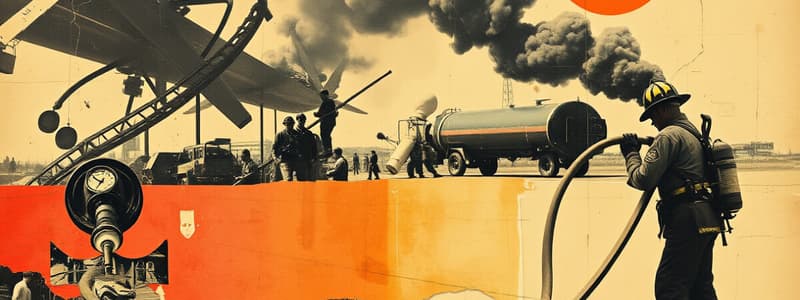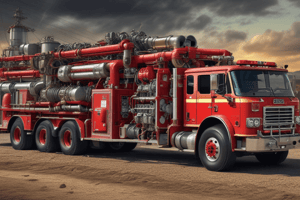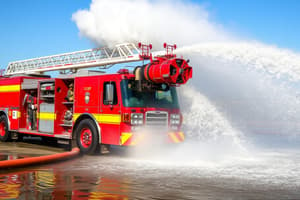Podcast
Questions and Answers
What is the recommended action to take if the weather is below freezing during operations?
What is the recommended action to take if the weather is below freezing during operations?
- Disengage the water recirculation system
- Leave the truck in neutral to prevent freezing
- Keep the pump gear engaged and recirculate water (correct)
- Add antifreeze to the pump system
What is a sign that the pump may be experiencing cavitation?
What is a sign that the pump may be experiencing cavitation?
- High water pressure
- Increased fuel consumption
- Reduced engine power
- A sound resembling sand in the pump (correct)
What must be done after draining sediment from the pump?
What must be done after draining sediment from the pump?
- Inspect the pump for damages.
- Refill the pump with water. (correct)
- Replace the pump entirely.
- Engage the engine brake.
What operational state should the engine brake be in when not on slick roads?
What operational state should the engine brake be in when not on slick roads?
What is the consequence of 'dead heading' the pump?
What is the consequence of 'dead heading' the pump?
To prevent freezing in smaller lines during cold weather, what must be ensured?
To prevent freezing in smaller lines during cold weather, what must be ensured?
What should be done with the tank-to-pump line during freezing weather operations?
What should be done with the tank-to-pump line during freezing weather operations?
When is it appropriate to completely drain the pump?
When is it appropriate to completely drain the pump?
What is the correct pressure at which to pump a 1-3/4 inch handline?
What is the correct pressure at which to pump a 1-3/4 inch handline?
If you are pumping over 1000gpm, what restriction is placed on the movement of the nozzle?
If you are pumping over 1000gpm, what restriction is placed on the movement of the nozzle?
What should be done to prevent the pump from building up pressure while driving?
What should be done to prevent the pump from building up pressure while driving?
What is the maximum pressure for the ground monitor on Ladder 1?
What is the maximum pressure for the ground monitor on Ladder 1?
How is the pressure adjusted when pumping a 2-1/2 inch handline with a smoothbore nozzle?
How is the pressure adjusted when pumping a 2-1/2 inch handline with a smoothbore nozzle?
What is a crucial action during emergency response operations while pumping?
What is a crucial action during emergency response operations while pumping?
What must be remembered when pumping under 1000gpm?
What must be remembered when pumping under 1000gpm?
Which of the following statements regarding the combination nozzle is correct?
Which of the following statements regarding the combination nozzle is correct?
What is the minimum intake pressure that should not be dropped below when catching a hydrant?
What is the minimum intake pressure that should not be dropped below when catching a hydrant?
What pressure should a 1.75 inch preconnected handline be pumped at to achieve a flow of 150 gallons per minute?
What pressure should a 1.75 inch preconnected handline be pumped at to achieve a flow of 150 gallons per minute?
What is the appropriate pump discharge pressure for a 2.5 inch smoothbore preconnected handline to achieve a flow of 265 gallons per minute?
What is the appropriate pump discharge pressure for a 2.5 inch smoothbore preconnected handline to achieve a flow of 265 gallons per minute?
What action should be taken to prevent damage to equipment after pumping is completed?
What action should be taken to prevent damage to equipment after pumping is completed?
Which of the following actions should be taken to assess a loss of water problem?
Which of the following actions should be taken to assess a loss of water problem?
What is the necessary preparation before starting the vent fan operation?
What is the necessary preparation before starting the vent fan operation?
Which tool should be prepared in the front yard for emergency deployment?
Which tool should be prepared in the front yard for emergency deployment?
What is a potential consequence of cavitation in a pump system?
What is a potential consequence of cavitation in a pump system?
Flashcards are hidden until you start studying
Study Notes
Pumping Operations
- Drain the ladder pipe after pumping to prevent equipment damage during retraction.
- Maintain intake pressure above 20 psi when hooking up to a hydrant as per PUC manual.
- Pump discharge pressure should be set at 160 psi at this station; adjust valve for correct pressure if using a 2-1/2 inch handline.
- Use correct nozzle opening to achieve desired pressure on the 2-1/2 inch handline.
Skills and Equipment
- Operate vent fan: ensure proper setup and checks before use.
- Practice single-man ladder raises using 24’ extension or roof ladder for accessing windows or rooftops.
- Prepare essential tools including RIT pack, stokes basket, and possibly K12 saw for deployment.
- For small handlines (1.75 inch), pump at 160 psi to achieve 150 gallons per minute.
- For 2.5 inch smoothbore preconnect, pump at 68 psi to achieve 265 gallons per minute.
Emergency Procedures
- Identify loss of water issues; use chains and wheel system for tire traction.
- Disable engine brake in slick conditions to avoid skids; otherwise, operate at maximum settings for stability.
- Regularly drain pump to remove sediment but ensure refilling for operation.
Pumping Challenges
- Avoid cavitation by ensuring RPMs and pressure are aligned; listen for abnormal sounds like grinding.
- Prevent overheating by ensuring water circulation; do not deadhead pumps to avoid damage to impeller.
- Maintain water flow to prevent boiling temperatures that can damage equipment.
Cold Weather Operations
- In freezing conditions, switch truck to pump gear and recirculate water; alternatively, drain pump and lines entirely.
- Ensure turret and booster lines are drained to prevent freezing, while keeping the pump filled with water.
Engine Operator Training
- Focus on driver responsibilities during fire pumping scenarios, including setting up vent fans and transporting tools.
- Practice skills without command awareness for proactive response.
- Establish pumping pressures during drills: 1-3/4 inch handlines at 160 psi for 150 GPM; 2-1/2 inch handlines at 78 psi for smoothbore, 120 psi for combination nozzles.
- Keep tank to pump line open and tank fill line cracked to avoid pressure buildup during travel.
Pressure Guidelines
- Maximum pressure for ground monitor on Ladder 1 is 175 psi, with smoothbore tips operating comfortably between 80-110 psi.
- Ladder pipe can withstand up to 200 psi.
- Maintain full range of motion for nozzles below 1000 GPM; restrictions apply for flows over 1000 GPM.
Studying That Suits You
Use AI to generate personalized quizzes and flashcards to suit your learning preferences.



